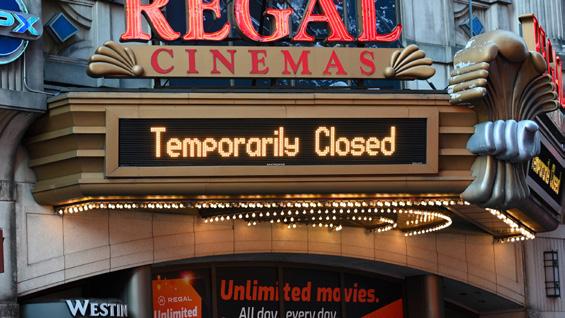
9 minute read
The Loneliness of COVID Cinematography
The Loneliness of COVID Cinematography: Part 1By Patrick McAuliffe
The last year and a half has taken much from us; more specifically, our governments have taken much from us. One trivial aspect of COVID hysteria that won’t leave my addled mind alone since it became apparent to me is how TV shows and movies are shot and edited in 2021. Pre-filmed movie footage and the ability of animated media to be produced remotely helped the entertainment industry peter along through the remainder of 2020, but as the pandemic wore on and more sectors of society reopened, it became increasingly obvious that COVID restrictions and conventions played some part, big or small, in how that movie or TV show was produced. Live-action Marvel shows on Disney+ utilized social distancing in a sneaky way, while “Afterllife of the Party” with Victoria Justice on Netflix was able to follow a similar, subtle pattern. One close examination of the restrictions behind the scenes can cause a change in the way a given piece of art is experienced, evoking feelings of emptiness, loneliness, or isolation. Entertainment was the one escape from the lockdowns and lack of interpersonal connection over the past year and a half, but our media sources continue to remind us of that loneliness.
Advertisement
Disney+ launched a few months before COVID became a serious international issue, and has since become a 100 million-subscriber cash cow for The Mouse. Beyond perusing the vault of terrible live-action 90s movies and paying $30 to the Xinjiang Tourist Department for early access to “Mulan”, many people subscribe to see the live-action MCU TV shows and keep up with some of the side cast of characters in the franchise. COVID social distancing restrictions’ impact on the cinematography of the shows first became apparent to me in “Loki”, although elements of distancing became clear in both “WandaVision” and “The Falcon and the Winter Soldier”. “Loki” follows the Norse trickster god’s misadventures following the events of “Avengers: Endgame”, in which Loki steals the Tesseract and teleports away from the Battle of New York in 2012, creating a divergent timeline and causing a full run-in with the Time Variance Authority, or TVA. The TVA is an extra-dimensional police force, purging universes that don’t follow a prescribed path for the MCU’s timeline, and Loki is conscripted by the TVA when a female Variant of his, named Sylvie, goes rogue. Owen Wilson and Tom Hiddleston’s chemistry is a delight to watch, but what struck me as odd was the number of situations in which the sets seem devoid of life. Much of Loki’s character development is done in a solitary room, watching himself change and die in his future timeline (past MCU movies), or in a time cell, where the only other person is Lady Sif slapping and kicking him in the genitals for all eternity. Mobius and Loki’s lonely interactions are done from across tables and desks in near-vacant cafeterias, offices, or prison cells. Hunter B-15 learns of her true past with Sylvie in an empty parking lot of a futuristic superstore, and earlier in the show, Loki battles mind-controlled puppets of Sylvie in the same evacuated superstore. In Loki and Sylvie’s final confrontation with He Who Remains, his vast, forlorn study takes up more space than his eccentric personality and the monologuing from across his desk. The Void beyond time, so aptly named, is a CGI wasteland as empty as the mountains in Lord of the Rings’ long, panning traveling shots. Where are the rest of the workers at the TVA, a sleepless hive of time enforcers? Where are He Who Remains’ staff and castle servants, tending to his needs for all eternity beyond time? Where are all of the people anywhere?
“WandaVision” moves slightly more towards “normal” cinematography, but the locales within the story and the themes they choose for the different eras of TV sitcoms betray the inopportune time of their filming. In this MCU show, a distraught Wanda steals Vision’s dissected body from the weapons R&D agency counterpart to S.H.I.E.L.D., fittingly named S.W.O.R.D. (looking at you, Pokémon fans), and retreats to a small town in New Jersey where she and Vision were planning to settle one day to raise a family. She resurrects him with her magic and creates a force field around the town, allowing her to live out the perfect life she always imagined before Thanos’ arrival on Earth. She
soon butts heads with S.W.O.R.D. as they investigate the “missing” town; they soon realize that the citizens of the town are mind slaves, forced by Wanda’s magic to act out parts in her own little sitcom that moves through the eras of TV, from the 1950s all the way to a “Modern Family”-style docutainment show of today. Most of these styles allow for distanced actors: in 50s and 60s shows, husband and wife (and other cast members) can flirt and make jokes from across the living room, kitchen, or bedroom; in the “canned laughter” era of the 70s and 80s, the actors’ blocking allows for much of the same, albeit in color; from the 90s and beyond, clever camera angles can portray intimate moments with enough distance so as not to spread communicable viruses. Much like in “Loki”, the streets of
“WandaVision” are usually bare, and at the edges of town, as Vision discovers on Halloween, many of the denizens simply freeze in place, apart from each other, unless given specific mental instruction from Wanda. After a bewitching and distant CGI finale in the sky between her and Agatha Harkness, Wanda retreats to the wilderness, another remote spot away from other disease-carrying humans. The busyness of the S.W.O.R.D. command base makes, at times, for a good cover that “WandaVision” isn’t a “COVID show”, but distancing requirements make themselves known elsewhere.
“The Falcon and the Winter Soldier” appears as the show most similar to pre-COVID entertainment, as the show’s titular characters race against time to stop Super Soldier terrorists called the Flag-Smashers from committing global acts of violence in the wake of Iron Man’s revivifying snap. People bustle to and fro on the dock in New Orleans where Sam Wilson’s sister keeps their parents’ boat; Falcon, Bucky, and Zemo visit a packed nightclub in the Indonesian city-state of Madripoor; refugee camps established by the Global Repatriation Council are filled with children running about and migrants engaging in non-distanced, non-masked conversation. Sam and Bucky even have a close-contact staring contest in therapy. However, in moments where Sam tries to reason with the leader of the Flag-Smashers, Karli Morgenthau, he usually does so from nearly across the room or down a long balcony. At the disciplinary hearing for John Walker, the new Captain America, his superiors are seated at a long table meant to impose distance between them; later, in the same room, Julia Louis-Dreyfuss’ sinister yet forgettable character makes Walker a lucrative offer after everyone else has cleared out. Regardless, “The Falcon and the Winter Soldier” may be a Marvel-head’s best hope of escaping the crushing feeling of emptiness that plagues the other two MCU shows.
“Homie,” you might say, “you’re thematically jumping all over the place! One minute it’s Marvel; down the line, it’s NBC; why shoehorn Victoria Justice in there?” I’m glad you asked, homie, because Netflix’s “Afterlife of the Party” is a good case for why COVID cinematography isn’t purely a TV show phenomenon. Not many movies were made during the pandemic, at least not many memorable ones. Theaters were closed, everyone was home, and as previously stated, it’s a hell of a lot easier to get graphic design students behind computers to slave away at animating over voice recordings than it is to get A- and B-list actors together in exotic and popular filming locations. Even Marvel, after all filming was done pre-COVID, held off on releasing “Black Widow” in theaters, despite the plan to release it in May 2020. It must be pretty integral to the MCU’s overarching story if they waited until Big Brother said that it’s ok to consume entertainment around other disease vectors- I mean people- again. No, I haven’t seen it; I’m never paying The Mouse for Premier Access to movies. I’m just waiting until October 6th when the plebians get to stream it. However, I digress. We return now to Ms. Justice. et over his divorce; her mother is the trickiest case, as Cassie still hasn’t forgiven her for leaving them when she was young. I say that this perfectly adequate angel movie strongly resembles the MCU shows in that most of the scenes are shot in spacious venues, focusing only on either a single character as others comment from the wings (pun intended) or two characters that interact closely for a brief moment before retreating to the corners and walls for the rest of the scene. The distancing struck me most severely in the scene where Cassie, running low on the arbitrary timer set by her guardian angel Val, goes to see the latter celestial being out of frustration that her efforts aren’t bearing fruit. She runs down a white, empty hallway and stops in the doorway to Val’s spacious lounge, and they continue to bicker about the necessity of her trial from the doorway and the center of the room, respectively. Why not go in and talk? Use the space you’re given! Angels can’t even contract diseases!
That was just a little funny business, but I’m serious when I say that “Afterlife of the Party” follows the subtle Disney+ path: no mention of the pandemic; no masked characters; yet elements of distancing and empty space everywhere, if one knows how to look. It’s a bit better than the blatant beatdown of pessimism offered in shows like “Grey’s Anatomy”, which spent the entire 17th season complaining that some people weren’t taking the pandemic as seriously as a biohazard removal worker and bringing back dead people on a beach so Ellen Pompeo had something to do during her character’s coma. Still, vast expanses of empty sets and unnatural blocking make for an uneasy feeling of dread in this viewer. The “no thoughts, head empty” of our generation is now held up as a mirror to us in our entertainment and in our world.
“Afterlife of the Party” is, at its heart, a fantasy for everyone who dies too young and doesn’t understand the good things in their lives. A la “Ghost Whisperer” or AHS’ Murder House, Justice plays Cassie, the party girl who hits her head on the bathroom sink and dies after a night of raging, both figuratively (under alcohol’s influence) and literally (getting into an argument with her straight-and-narrow roommate Lisa). One year later, she comes back as a rookie angel that must help Lisa, her grieving father, and her divorced, liberated mother in unspecified ways particular to each person that she must discover for herself. Lisa needs to break away from drowning her grief in her work at the museum and date her British neighbor; her father needs to rediscover his passion for yoga and bury the hatch-










